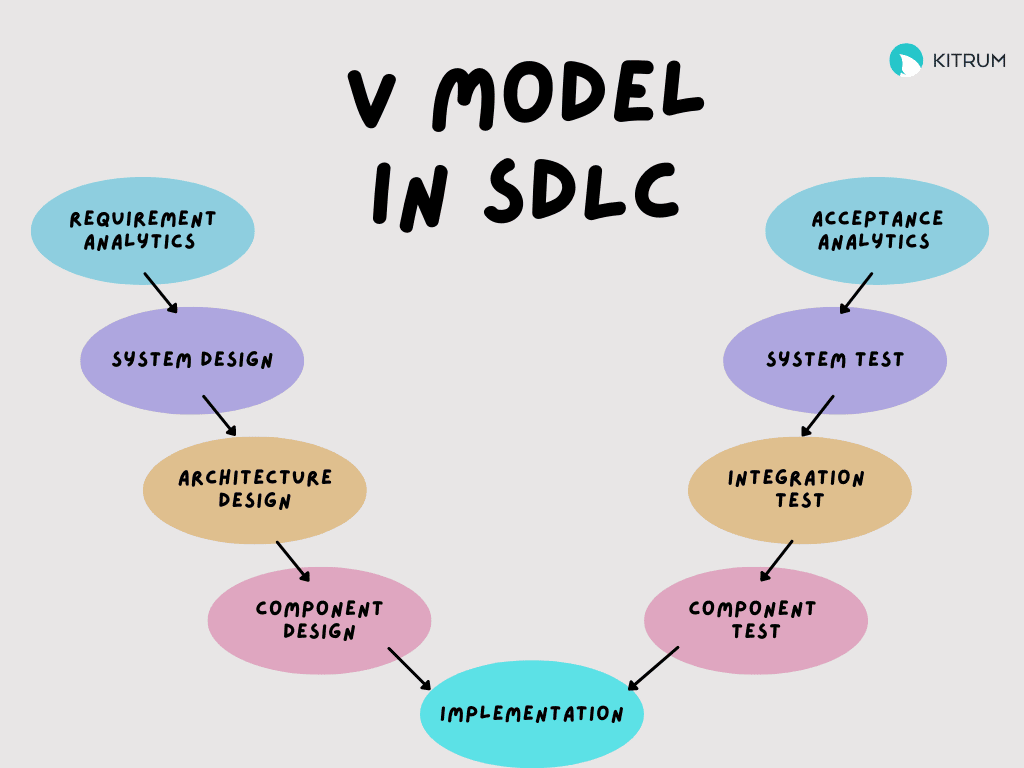V-Model: Low-Risk and Cost-Effective Software Development Lifecycle Method
If you’re already familiar with the waterfall model of product development it’s gonna be easy for you to get an idea of a new coming trendy approach – the V model.
Software development requires a lot of planning, and the better this process is organized, the more smoothly the workflow goes and the more predictable the outcomes. The software development life cycle (SDLC) is a framework organized by specific actions to be taken while building a tech product. Basically, those are the step-by-step phases undertaken by the development team from the start until the release of the software. Usually, it consists of requirement analysis, design, development and testing, implementation, documentation, and evaluation.
There are different methodologies in SDLC, and choosing the right one for your project will depend on various factors. For example, you may consider the size of the team and their skills, engineering capability, technology, stakeholders’ priorities, and the complexity of the software you build. To choose the right SDLF methodology, you need to make an analysis and even draft your own criteria depending on your own project.
One of the types of SDLC that is becoming more and more used is a V-model. The process is performed consistently following the V-shape. It consists not only of the development cycle but also of the testing cycle. The difference between this methodology from others lies in the consequential testing at each stage of development. Each stage of the development process is succeeded by testing. For example, unit tests are written during coding.
The new stage doesn’t start until the previous one is over. The main benefit of the V-model is that each solution is tested even at the initial design stages.
The V-model is especially useful while developing systems that are vital for smooth and seamless functioning. For example, application programs in clinics for monitoring patients, integrated software for control mechanisms for emergency airbags in vehicles, and so on.

Why is testing so important?
Performing tests during the first stages of product development can save you time and money. The estimations of thousands of projects showed that bugs that appeared in the development and design process make up almost half of the total number of bugs. Furthermore, the cost of bug fixing rises through the whole lifecycle of product development.
Working on a big project with complex systems may result in missing key details even in the stage of requirement analyses. In that case, the client can receive the product, which doesn’t correspond to what he wanted to build, and the work can start from zero again. On the other hand, the development team can consider all the requirements but make serious mistakes in the design or architecture of the project, so you should make changes to fix them.

Composition of the V-model
V-model can also relate to Verification and Validation Model. Those are the two main phases joined by the coding.
Verification is the process of determining whether the following state of the development achieved during a specific stage corresponds to the requirements of the stage. It allows you to evaluate the compliance of development parameters with the original requirements. Verification overlaps with testing, which is connected to identifying differences between actual and expected results and evaluating whether the software features meet the original requirements. The issues of identification, description, and control of the configuration of individual components and the entire system as a whole are important in the development process. It is done through static analysis – review – without code execution.
Validation is aimed to answer the same question, whether the product meets all the requirements and expectations of the customer, all the functions are performed according to the goals and needs. It is performed through dynamic analysis, including functional and non-functional testing through code execution.
Verification process consists of the following phases:
– Requirement analysis is when the development team collects the requirements of the products from the client’s point of view. It involves extensive communication to get a deep and profound understanding of what the client wants to receive as a final product: the goal and what functions should perform in non-technical terms. The requirements can be further used as input for the acceptance testing, so during this phase, the design plan of the acceptance test is drafted.
– System Design implicates designing the whole system, detalization of the hardware, and communicating the product setup. The system test plan is prepared after considering the system design. The earlier it is done, the more time if left to perform the actual test later.
– Architect Design means breaking the parts of the system design into modules with different functionality. Internal communication and data transfer between the modules is set during this phase. It makes it possible to design integration tests.
– During the module design phase, the system modules’ detailed internal design is developed. Based on it, unit tests can also be created.
Validation process is composed of several various tests, such as:
– Unit testing is performed while the module design validation phase. It is done at the code level and allows for reducing the number of bugs in the early stages.
– Integration testing is related to the architect design phase, aiming to test the internal modules’ communication and compliance.
– System testing checks the functionality of the whole system and its communication with external systems. During those tests, you can check the compatibility of software and hardware
– Acceptance testing is performed by testing the product in the user’s environment and its compatibility with other systems. It answers the question of whether the product meets the need of the users and is ready to be released.
Pros and Cons of V-model
While developing a product using a V-model, the testing is performed from big to small. The requirements are divided into high-level design and detailed design phases. And through the course of work, they become more detailed and precise.
As well as, all processes within this model require good documentation by the project development team and the support team, which can further be used to maintain the product once it is in the development environment.
The V-model is scalable and can accommodate almost any IT project, regardless of size and complexity. It is easy to understand and manage. But if your project requires changes, the model is not flexible enough to implement them.
V-model works well for small projects with precise requirements, but when it comes to long and ongoing projects, it’s already complicated to accommodate it. It is especially hard to come back and change functionality once the testing stage is in process. Also, you should keep in mind that working software is developed at the implementation stage, so it’s unable to create a prototype of the product and test it before release.



